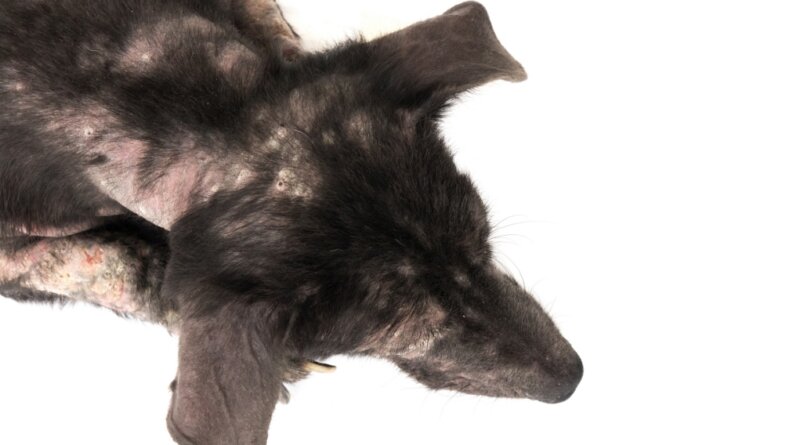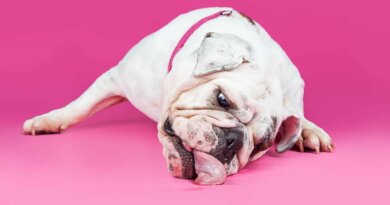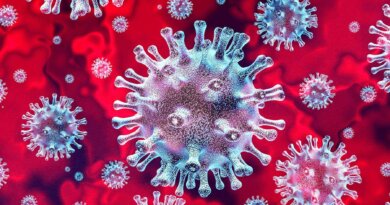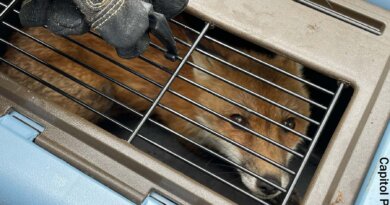Dog Hair Loss Home Remedies – Top Dog Tips
Hair loss is dogs is not uncommon. Also known as alopecia, this condition is not the same as the natural act of shedding fur. Shedding is when old or damaged pieces of fur naturally fall out. These dog hair loss home remedies are used when your dog is suffering from unnatural hair loss that may present in missing patches of hair or complete hair loss.
Alopecia in dogs, or hair loss, is a common disorder that causes partial or complete dog hair loss. It can not only affect your pet’s skin, but also their endocrine system, lymphatic system, and the immune system. Alopecia can affect dogs of all ages, breeds, and gender. For this reason, it’s important that you consult your veterinarian to treat the underlying condition and ensure that there aren’t any major health concerns.
For the most part, dog hair loss will be very noticeable to owners, and it may show up in different patterns and shapes. It can be sporadic or symmetrical hair loss, or may present as bald circles. Hair loss can be accompanied by crusting and inflammation of the dog’s skin. In very rare cases, the dog may have scaling of the skin too.
Hair loss in dogs may be caused by a number of reasons, including allergies, infections or parasites. Depending on the underlying cause, canine alopecia may be accompanied by infection and irritation, along with possible reddening of the skin in the effected area.
Before you decide to use one of these dog hair loss home remedies, I recommend you call your veterinarian for a consultation. If the underlying cause of the hair loss is an allergy or infection, for example, a home remedy may fix the problem for now, but it will keep coming back until the underlying cause is treated.
Dog Hair Loss Home Remedies
 1. Apple Cider Vinegar
1. Apple Cider Vinegar
Apple cider vinegar has been shown to have antibacterial, anti-fungal and antiviral properties. Do NOT use it directly on your dog’s skin, because the high acidity of apple cider vinegar could actually be harmful to the dog. It could irritate your pet’s skin and cause a burning sensation.
Use an organic type of apple cider vinegar (like Bragg), and make a 50/50 blend of apple cider vinegar and water in an empty spray bottle. You can apply the spray to your dog 2-3 times per day until the hair begins to grow back. You can continue to use the apple cider vinegar spray once per day as a treatment remedy once the hair begins to grow.
This spray should not be used if your dog has open wounds on their skin. It will sting and cause him unnecessary pain. You should also pay close attention to the areas of skin where you use this spray. If you notice the condition of the skin getting worse, seek veterinary treatment.
2. Coconut Oil
Coconut oil has many positive effects on a dog’s skin and coat health. It can help with skin conditions like eczema, contact dermatitis, itchy skin and generally improve skin health. It can also reduce allergic reactions.
Skin cuts and wounds can also be treated with coconut oil. It can disinfect cuts and promote the healing of wounds. It can also help with the treatment of dry skin, hot spots, bites and stings, as well as other skin allergy related symptoms.
Coconut oil can be given to dogs orally or applied topically. Adding organic coconut oil (like Viva Naturals) in your dog’s diet can improve their health in general, but for the best results regarding skin and coat health, coconut oil should be used topically.
The amount of oil to add to your dog’s food depends on his size. For example, many vets recommend that you include coconut oil in small quantities about 1/4 of a teaspoon for small dogs on a daily basis. For large breeds, about 1 teaspoon per day can be added to their meal.
Using coconut oil topically is even more simple. It’s important to start with small amounts because your dog’s fur can get greasy if you apply too much. Just rub a bit of coconut oil between your hands and put it in on the affected areas.
Coconut oil is not toxic, so you don’t have to worry if your pooch licks his skin after you apply it. You can apply it topically once or twice per day until the hair grows back. You can continue using it once the hair grows back to keep your dog’s skin and coat shiny and healthy.
 3. Vitamin E Oil
3. Vitamin E Oil
You can purchase Vitamin E oil at most pharmacies or natural living stores. Applying the oil topically to bald spots on your pet’s skin will help the skin heal faster and the hair begin to grow.
Vitamin E is an antioxidant that helps to defend against free radicals in the skin. It is also good for your dog’s immune system, heart and liver health and overall skin and coat health.
4. Lemon Juice
Did you know that lemon juice has anti-bacterial properties because of the high amount of citric acid it contains? If your dog’s hair loss is caused by a bacterial infection, lemon juice is an easy and affordable natural remedy.
Infuse a quart of warm water with a few slices of lemon for about 5 hours. Strain the liquid afterward to remove any pulp or leftover lemon particles. Put the liquid in an empty spray bottle and apply it to the affected areas 2-3 times per day.
READ NEXT: 9 Common Skin Problems In Dogs (How To Prevent and Treat Them)







Read here. Get here.
https://finasteridest.com/ how to get generic propecia tablets
Commonly Used Drugs Charts. Commonly Used Drugs Charts.
Top 100 Searched Drugs. Get here.
where to buy clomid tablets
Long-Term Effects. Top 100 Searched Drugs.Amox
Best and news about drug. Everything about medicine.
amoxicillin online purchase
Drug information. Some trends of drugs.